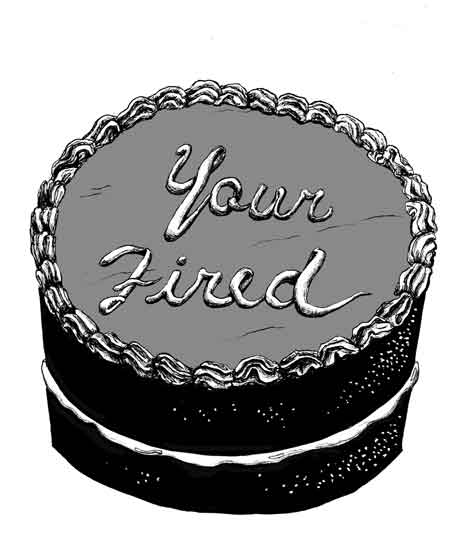I spend a lot of time finding ways to make paintings that (I always hope miraculously) look like they aren’t paintings.
And then I get what I wish for and they get mistaken in print for collages or computer things or photos of people by journalists who didn’t read the wall label. And then I get angry. And then I get a deadline for a column and write about it, like a jerk. Because it’s on my mind.
And then I look at it, and it’s a stupid rant about fact-checking written while the government’s about to default on its debt and Syria burns and Guantanamo still isn’t closed.
But, indulge me—I’m going to make a pitch for fact-checking art reviews being, maybe, part of something important.
LET’S ASSUME YOU’RE EMPLOYED.
Think about the walk to the back office, or the phone call from whoever’s in charge: The discussion of your performance.
How bad does a thing you did have to be before you get fired? Not, like, rubbing snot on the boss’s nipples—not something personal—something that would demonstrate that—whatever the basic skill you need to do the job is—you don’t own it.
An art critic agrees to deal, like every writer, with grammar, usage and deadlines, and, unlike every writer, with recording their opinion.
So once you can write at all, it’s pretty hard to do job-endingly wrong. Its least nebulous requirement is giving the impression that one meets all its nebulous requirements.
It can, however, still be done objectively wrong. There is such a thing as a literally worthless opinion—a rose isn’t a rose if you haven’t got a nose and a man without a mouth should not be judging sundaes. In art criticism, this happens: they don’t send the blind out but they’ll send the lazy. So you get reviews of shows unseen. I noticed it first when I was an intern—the titles didn’t match, the critic had obviously only looked at the catalog.
You couldn’t have an opinion more bad than that: one totally uninformed in the simplest sense of the word. You (and think how rarely you get to use this sentence literally) do not know what you’re talking about. And critics don’t get fired for that or things like it.
We don’t and can’t and shouldn’t live in a world where we can identify a wrong taste in art. All objects from mute cubes to kitsch cabin oils have their counterargument. But we have tools to identify those too stupid or negligent to even be making arguments—but we don’t use them. So anyone who wants to think about art has to wade not only through a necessary democratic noise but also through a gratuitous criminal noise. It can be important to hear the ideas of an 8th grader who doesn’t know much about art but knows what she likes but it can’t ever be important to hear the opinion of a middle-aged multi-graduate who doesn’t even know what it is he’s liking. The art journalists who make up things because they can’t read the labels or ask for clarifications don’t suck any less at their easy job than the police and political journalists who are destroyed by the scandal of their fabrications, it’s just that the former’s fuck-ups fuck up only art, where the stakes (at least in the short term) are desperately low.
The real job of an art critic in most news organs is to be part of a bigger machine: it’s just the art part (a minor but colorful part) of a larger opinion engine’s thrust.
A paper’s culture section projects a certain attitude, finds people who want to hear it projected, and finds objects to project it onto. But that’s just Twitter, and Twitter’s free. The demand for lines of strung adjectives flung blindly is high, but so is the supply. Without thought or analysis grounded in things that actually are, the market in these ideas will go rapidly down—and without some attention paid to making sure the observers are actually observing, the things beneath the surface will cease to be recognized, then cease to be rewarded, then cease to survive.


